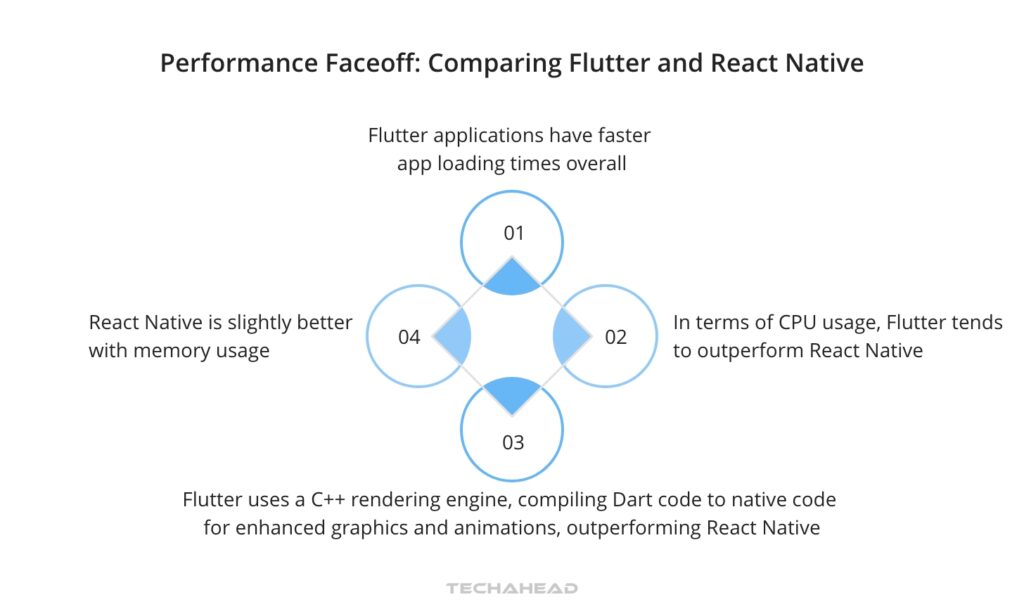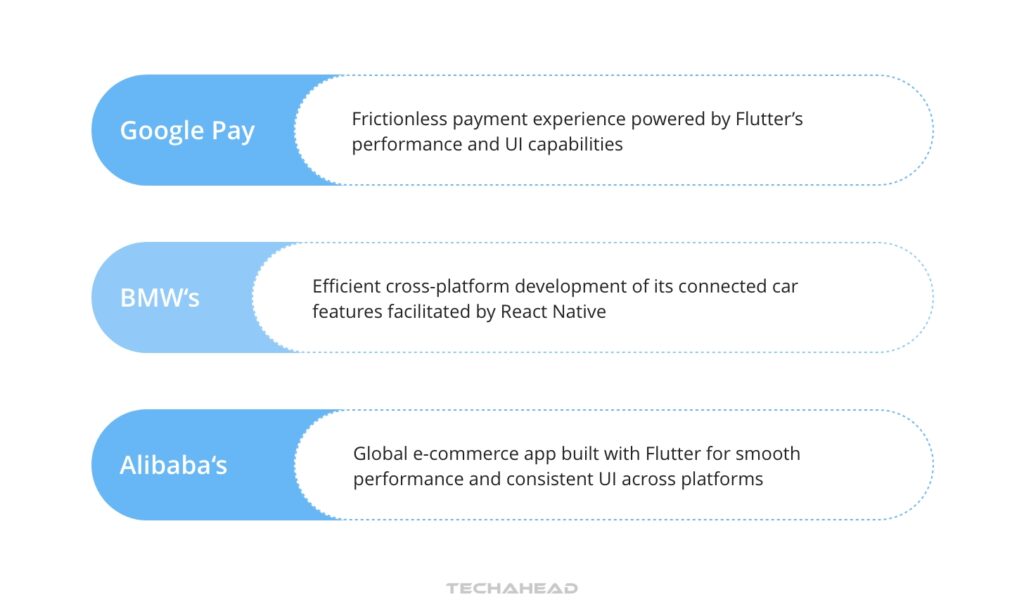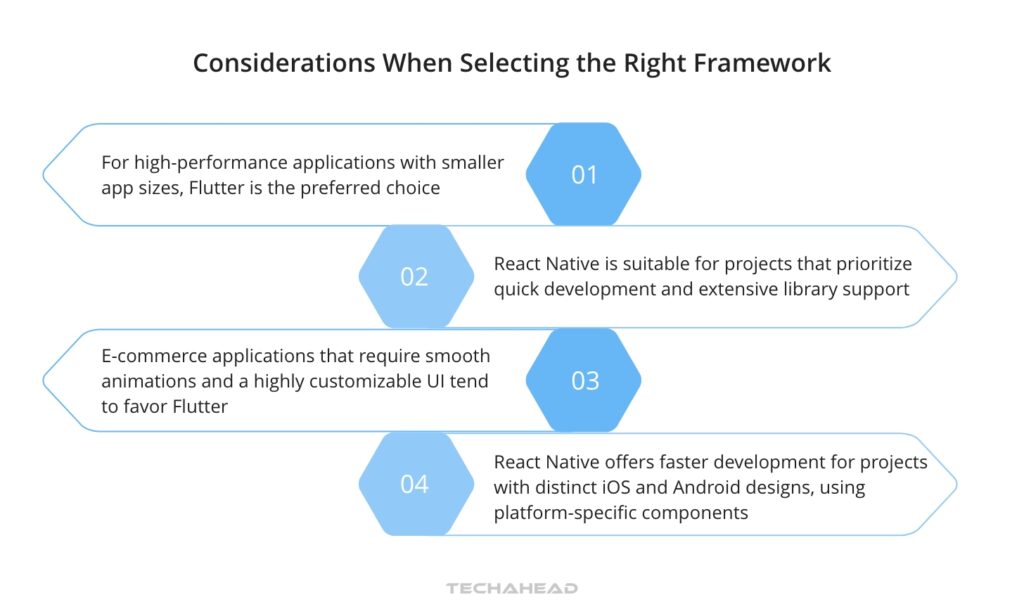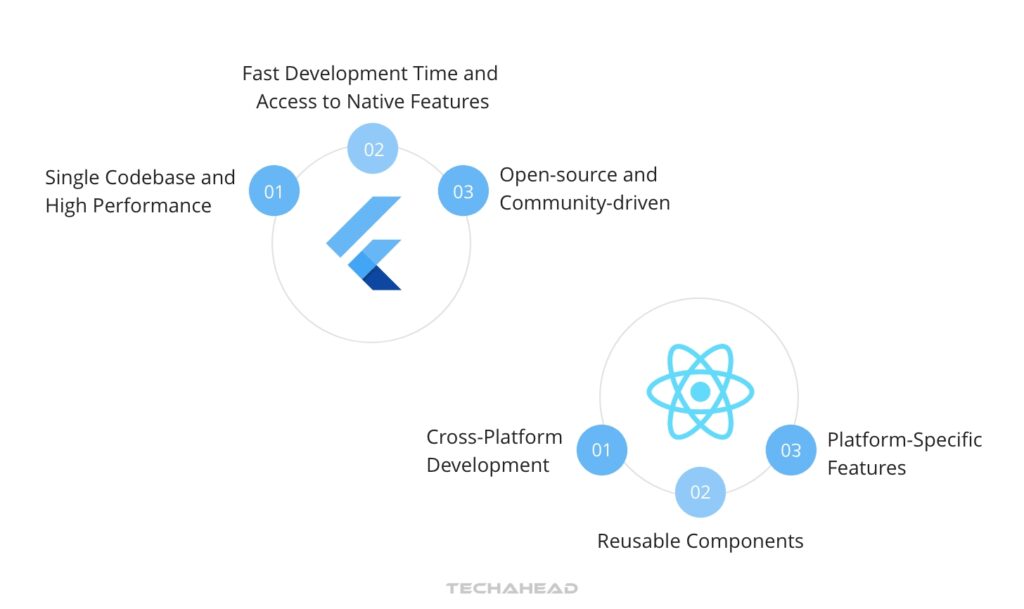
Are you weighing the pros and cons of Flutter vs React Native in 2024? With a clear focus on current trends and advancements, our comprehensive comparison strips away the hype to guide you through performance metrics, ecosystem maturity, developer experience, and cost – all to pinpoint the right choice for your app development needs.
Key Takeaways
- Flutter and React Native are both leading cross-platform mobile app development frameworks, with Flutter offering comprehensive code reuse across various platforms, including mobile, web, and desktop and React Native providing extensive library support and a larger community.
- While Dart, used by Flutter, is optimized for high performance with compilation advantages, JavaScript, the language behind React Native, offers widespread use and a wealth of learning resources but showcases slower performance benchmarks compared to Dart.
- Both frameworks have their unique advantages in terms of UI design, performance, developer productivity, and community support, with no clear consensus on which will dominate the future market, making the choice dependent on specific project requirements, developer expertise, and desired platform support.
Exploring the Evolution: Flutter and React Native in 2024
Since their initial launch, both Flutter and React Native have undergone substantial evolution. Flutter, with its optimized C++ rendering engine, offers top-notch performance in producing native-quality graphics and animations. However, its apps are relatively large due to its single code base, which simplifies maintenance and streamlines the process for cross-platform development. Regular updates are recommended to benefit from the latest security patches, bug fixes, and to address potential vulnerabilities.
React Native, however, as a more mature platform, has a larger community and a broader ecosystem than Flutter. Its performance may be limited based on the capabilities of the underlying native UI elements, as it uses the native rendering engine on each supported platform. Yet, its ability to reuse code across various platforms like iOS, Android, web, and potentially desktop platforms makes it a compelling choice for many developers.
The Battle of Programming Languages: Dart vs JavaScript

Dart and JavaScript are the prominent programming languages behind Flutter and React Native, respectively. The dart programming language, used by Flutter, is a class-based, object-oriented language with C-style syntax developed by Google in 2011. It provides interfaces, mixins, abstract classes, and static typing, creating a type-safe environment. On the flip side, Dart’s performance is enhanced by both Just-In-Time (JIT) and Ahead-Of-Time (AOT) compilation, making it faster than JavaScript.
React Native utilizes JavaScript, a popular programming language that enables both object-oriented and functional programming, eliminating the need for client-side compilation. Despite having a steeper initial learning curve, JavaScript’s learning resources are plentiful, making it accessible to many developers. However, being interpreted and usually faster to execute, JavaScript has been benchmarked to be slower than Dart.
Cross-Platform Efficiency: Building iOS and Android Apps with Flutter and React Native

A distinctive advantage of both Flutter and React Native is their capacity for cross-platform app development, allowing the creation of iOS and Android apps from a single codebase. This capability significantly reduces development time and cost, making React native apps and native app development more efficient.
Flutter shines in this regard, with its capabilities extending to:
- web
- macOS
- Windows
- Linux
- Android
- iOS
- embedded systems
This emphasizes comprehensive code reuse.
However, React Native is not far behind. It facilitates code reuse across iOS, Android, the web, and potentially desktop platforms. To maintain a consistent user interface across platforms, React Native may require third-party libraries, while Flutter incorporates a uniform set of widgets, aiming to align their API across platforms.
UI Design and User Experience: Flutter’s Widgets vs React Native’s Components

The success of an app significantly hinges on its user interface design. Here, Flutter stands out with its widget-based approach. StatelessWidget and StatefulWidget are employed to implement UI, differentiating depending on whether a widget manages the state and encapsulates a build function that constructs the UI based on the current state and configuration. These widgets are highly customizable, with extensive style properties that allow developers to fine-tune the appearance and behavior, frequently combined to create sophisticated UI compositions.
Conversely, React Native relies on native UI components. While they provide a more native feel, the requirement for third-party libraries to maintain UI consistency across platforms can be a drawback. However, the framework enables code reuse across various platforms, thus speeding up the development process.
Performance Faceoff: Comparing Flutter and React Native
Evaluating a framework necessitates considering performance as a crucial factor. Here is a comparison of Flutter and React Native:
- Flutter leverages a C++ based rendering engine and compiles Dart code into native code, which offers native-quality graphics and animations with performance advantages over React Native at the rendering level.
- In terms of CPU usage, Flutter tends to outperform React Native.
- React Native is slightly better with memory usage.
- Flutter applications have faster app loading times overall.
Nevertheless, React Native remains a formidable contender. Introducing the New Architecture, featuring Turbo Native Module and Fabric Native Components, aims to enhance performance and stability, replacing the legacy bridge-based system. Yet, when it comes to high-performance applications like games or real-time streaming, Flutter’s high-performance capabilities and consistent UI across platforms make it a better fit.
Developer Productivity and Tools: IDEs and Hot Reload Features
Developers can significantly benefit from productivity-boosting tools. Flutter developers can choose from a variety of IDEs and editors, such as Android Studio, IntelliJ IDEA, and Visual Studio Code, all supporting Dart. The Hot Reload feature in Flutter is a major boon for developer productivity, allowing immediate visualization of changes without needing a full rebuild, making it especially valuable for startups that prioritize quick iteration cycles.
Alternatively, React Native developers gain advantages from the comprehensive JavaScript ecosystem, which also includes native development. This enables them to use a wide range of IDEs and editors that come with JavaScript support, thus improving productivity through the libraries and packages available.
Ecosystem and Community: Vast Networks Supporting Flutter and React Native

The development process is significantly facilitated by a strong ecosystem and community backing. React Native holds an advantage here, owning to its larger community and ecosystem, leading to superior third-party library support. However, Flutter is catching up with over 23,000 packages and close to half a million repository results on GitHub. Issues in Flutter’s GitHub repository often met with a high number of solutions, highlighting an engaged and solutions-driven community.
Despite the rapid growth of the Flutter ecosystem, Dart’s ecosystem faces challenges such as a smaller community and more limited resources compared to JavaScript’s widespread usage across big tech companies. However, the high demand and supply for React Native developers mean it continues to be a popular choice in the market.
From Theory to Practice: Real-World Applications of Flutter and React Native

From Theory to Practice: Real-World Applications of Flutter and React Native
The success stories speak for themselves. From:
- Google Pay: Frictionless payment experience powered by Flutter’s performance and UI capabilities.
- BMW‘s: Efficient cross-platform development of its connected car features facilitated by React Native.
- Alibaba‘s: Global e-commerce app built with Flutter for smooth performance and consistent UI across platforms.
Many companies have reported significant boosts in productivity by incorporating Flutter into their development workflow, especially when creating Flutter apps. The use of Flutter has allowed these companies not only to increase development efficiency by up to 77% but also to maintain product integrity while shortening feature development cycles from months to weeks.
Cost Analysis: Development Expenses for Flutter vs React Native Projects
The cost implications of hiring and retaining developers play a significant role in selecting a framework. The average annual salary to hire a Flutter developer is roughly $130,000, while a React Native developer may charge around $125,000 per year on average. However, these costs can vary significantly across different countries, with hourly rates reflecting this geographical variation.
While Flutter’s increasing popularity is leading to a surge in demand for developers, there is a scarcity of Flutter developers on the market, which can often lead to challenges in hiring and maintaining project staff. However, considering the longer presence and larger adoption of React Native in the market, it may offer more job opportunities for developers.
Tackling Advanced Features: Access to Native Modules and Code
For developers, the ability to access native modules and code for advanced functionality can be transformative. React Native enables integration with native modules, allowing components to utilize native iOS and Android code through a bridging system. Developers can create and use Native Modules in React Native directly within the project’s native codebase, promoting code reuse and direct interaction with native APIs.
Conversely, Flutter uses a message-passing system for interaction with the native platform, facilitating method calls and binary serialization of values. Developers can use the Pigeon package to facilitate structured and type-safe communication between Flutter and the native host platform. This ability to access platform-specific APIs using native programming languages like Kotlin, Swift, and C++ on various operating systems makes Flutter a versatile choice.
Learning Curve Considerations: Should You Learn React Native or Flutter?
When deciding between Flutter and React Native, the learning curve carries considerable weight. React Native leverages familiarity with React, using the same syntax and principles, making it more approachable for developers with React experience. However, JavaScript’s widespread use and a vast array of learning materials can flatten the learning curve for newcomers aiming to adopt React Native.
On the other hand, developers who know Dart will find the transition to learning Flutter easier due to the language’s simplicity and readability. For beginners, especially those with a UI development background, Flutter’s widget-based development is intuitive and straightforward to learn. The gentle learning curve of Flutter, coupled with its increasing use by businesses, is enhancing its appeal and adoption globally among professional developers.
Flutter’s Rise in Popularity: Is It Outshining React Native?
Flutter appears to be making strides in the battle for popularity. According to the Stack Overflow Developer Survey 2022, Flutter surpassed React Native in the ‘most popular technology’ category. Google Trends data also demonstrates that Flutter overtook React Native in search queries globally and continues to maintain its lead into 2023. Statista’s research as of July 2021 indicated that Flutter had become the leading cross-platform mobile development framework, surpassing React Native by 4%.
Despite Flutter’s ascending popularity, the high demand and supply for React Native developers indicate that it continues to be a popular choice in the market. Considering its longer presence and larger adoption in the market, React Native may offer developers more job opportunities than Flutter. However, there is no consensus among industry experts on which framework will dominate in the future, with both Flutter and React Native having distinct advantages, strong support, and sizable user bases.
When to Choose Which Framework: Flutter vs React Native Use Cases

The selection of an appropriate framework frequently hinges on the unique requirements of a project. Here are some factors to consider:
- For high-performance applications with smaller app sizes, Flutter is the preferred choice.
- React Native is suitable for projects that prioritize quick development and extensive library support.
- E-commerce applications that require smooth animations and a highly customizable UI tend to favor Flutter.
- React Native may provide a faster development experience for projects where iOS and Android designs are distinct, leveraging platform-specific components.
Flutter is optimized for scenarios with a uniform design across both Android and iOS but can be more time-consuming if platform-specific UI differences are significant. Therefore, both Flutter and React Native should be evaluated based on various factors such as:

- Performance
- Compilation
- UI capabilities
- Developer tools
- Community support
- Documentation
Securing Your App: Flutter and React Native’s Approach to Security
App security constitutes an integral aspect of the development process. Flutter excels in security aspects due to built-in features such as secure storage, encryption, and sandboxing, making it a more secure choice for projects. In Flutter, data protection can be enhanced by measures including implementing certificate pinning, network whitelisting, antivirus libraries like flutter_jailbreak_detection to identify compromised devices, and the use of plugins such as screen_protector to manage background snapshots.
Alternatively, React Native’s ability to integrate with native modules can bolster security. However, when using SSL pinning in React Native, developers must plan for certificate expiry, typically between 1-2 years, and ensure updates are made in the app and on the server.
Looking Ahead: The Future of Mobile Development with Flutter and React Native

Looking forward, it’s evident that both Flutter and React Native will maintain their significant roles in mobile app development. Flutter is projected to shape the future of mobile app development, with experts notably recognizing its potential influence. Its ongoing development signals a strategic expansion beyond mobile, aiming for a cross-platform approach with an emphasis on desktop application capacities in upcoming releases.
Contrarily, React Native remains a popular choice among numerous developers, credited to its vast community, comprehensive libraries, and code reusability across multiple platforms. Both Flutter and React Native are positioned to continue as popular choices for developers without clear evidence pointing towards the foreseeable dominance of one framework over the other.
Summary
In conclusion, both Flutter and React Native are powerful frameworks, each with their own strengths and weaknesses. Flutter, with its Dart programming language and C++ rendering engine, offers high-performance and visually compelling applications. Its widget-based approach to UI design and the ability to build iOS and Android apps with a single codebase make it a promising choice for mobile app development.
On the other hand, React Native, with its JavaScript programming language and large community, offers a more native feel to applications. Its ability to reuse code across various platforms and integrate with native modules makes it a compelling choice for many developers. The decision to choose between these two frameworks should be based on the specific requirements and needs of the project.
Frequently Asked Questions
What is the difference between Flutter and React Native?
The main difference between Flutter and React Native development lies in the programming language used and how developer-friendly they are. Dart, the language of Flutter, is considered easier to work with and closer to native mobile app development compared to JavaScript used in React Native development.
Is React Native still relevant in 2024?
Yes, React Native remains relevant in 2024 due to its strong community support, maturity, and extensive ecosystem of libraries and tools.
What are some real-world applications of Flutter and React Native?
Real-world applications of Flutter include companies like ByteDance, Google Classroom, and Alibaba, while React Native is favored for its large community and extensive libraries. Both are used by a range of companies for their development workflows.
What are the key differences between Flutter and React Native in terms of performance?
In conclusion, Flutter offers better performance at the rendering level and in terms of CPU usage, while React Native is better with memory usage and provides a more native feel to applications. Both have their own strengths based on performance considerations.
How do Flutter and React Native differ in terms of their approach to security?
In conclusion, Flutter emphasizes security through built-in features like secure storage and encryption, while React Native can enhance security by integrating with native modules. Both frameworks have different approaches to addressing security concerns.



